One of the most successful
projects of the MIT Radiation
Laboratory in microwave radar was the SCR-584 radar, an anti-aircraft
gun laying system. This feat was accomplished under the guidance of Ivan
Getting and Louis Ridenour, although many very brillant individuals were
also involved.
This page is a memorial to
their genius, a virtual obelisk raised in their honor. Though my
career in radar and microwave radio began 42 years after the SCR-584 became
operational, I feel a certain connection to their genius. In my studies
of the Radiation Laboratory journals, I am humbled by the accomplishments
of this team. The SCR-584 and its technology are a monument to the
Gemini-twin philiosophies of Ockham's Razor and KISS. In an
age when it was an accomplishment to get a thousand vacuum tubes to function
for more than a few hours, the Rad-Labbers, by dint of God-given talent,
hard work, and the genius of simplicity, wrought a beautifully-simple and
deadly-accurate radar which won a war, and inspired a generation of radar
designers.
I also hope to honor the brave
GI's who operated the SCR-584 in World War II, and those who used the '584
in the "Golden Age" of aircraft and missiles, beating a WW-II sword into
a Cold-War plowshare. Tell your SCR-584 stories, one and all, so that the
world may learn what was done for the protection and prosperity of the
United States of America, and free peoples around the world.
New!
-
3-29-2006 Added Ed Bean's RAWIN story.
-
7-1-2004 Julius Hawk sent me some nice pictures of a restorable SCR-584
he's seen. I put them up in the "SCR-584 On The Web" section, below.
-
10-28-03 Removed references to MITRE in context of the MIT RadLab.
I was kindly corrected by Dr. Lee at Stanford that while MITRE personnel
did come from the RadLab, there is no direct organizational connection.
-
10-10-03 Added links to more "War Electronics Report" articles from 1946
(thanks Fred!)
-
11-19-02 Added Greg Goebel's website.
-
8-26-02 Added 2nd installment of the Electronics Magazine 1945-1946 series
on the SCR-584.
The Team
It is this incredible team at the MIT
Radiation Laboratory that I hope to honor with this page. These
men are the giants, upon whose broad shoulders my generation of engineers
stands. Thanks to the IEEE History Team, you can even read their
inspiring stories on the web! This list is ever-expanding, as I learn
of more individuals roles in the SCR-584.
The SCR-584 team was under extreme time pressure to get the radar going,
yet they succeeded brilliantly. They used what now would be called
"rapid prototyping", utilizing as much off-the-shelf stuff as possible,
often in very creative ways. I love this quote, from the Lee Davenport
IEEE interview:
" We had no compunction whatsoever about bending the
rules a little bit if necessary to get something done. We would buy a washing
machine if it would bring a quicker result....we were expected to hurry
and we were not to be put aside for anything. That permeated the building
of XT-1 [the SCR-584 prototype]. The first
experimental truck was a project that we moved heaven and earth to get
done quickly. We had no reluctance whatsoever about going to an outfit
that could spin a 6-foot aluminum parabola..."
I'm glad that, in the end, they only had to spin the dipole in the feed,
not a 6-foot aluminum parabola! That reminds me of one of my
own wacky radar experiments... Anyway, here's to the SCR-584
development team:
-
Henry B. Abajian: XT-1 power, SCR-584 European support (interview)
-
Britton Chance: XT-1 and SCR-584 ranging circuits, other circuit design
(interview)
-
Lee L. Davenport: development and field testing of the XT-1, SCR-584 field
support (interview)
-
Ivan Getting, project manager, magnetron modulator, Roof System and XT-1
(interview)
-
George Harris
-
Nathaniel B. Nichols: control systems (obituary)
-
Dr. Ernest C. Pollard: Moving Target Indicator (display) (interview)
-
Louis Ridenour, project manager
-
Leo Sullivan, electrical engineer (interview)
-
Dr. Fred B. Wood, Sr.: design of key microwave components. (bio)
The Technology
Vacuum-tubes? Yes, vacuum tubes! But that wasn't the
extent of the SCR-584's technology. An entire engineering discipline,
microwave systems engineering, had to be invented by the Rad-Labbers just
so that the SCR-584 could exist! Some of the books describing Rad
Lab tech are still in print!
-
Radiation Lab Series: This journal includes the Fabulous 584 and
the microwave technology behind it. Available on CD at www.artechhouse.com
for $295. The entire series is on 2 CDs.
The Radar
You'll soon know why I get so weepy over an S-band conical scan radar.
This thing is completely beautiful in the simplicity of its design.
This is a short list of articles and diagrams describing the SCR-584's
brillant design, flawless execution, and deadly functionality.
-
RAD LAB JOURNALS: Vol. 1 pps 207-210, 228, 284-286.
-
SPECIFICATIONS
-
SCR-584 Repair Manual (Yes, I finally have one!):
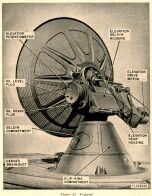
|
Back side of pedestal
and dish (783K JPG), showing elevation pot (with OIL plug!) and selsyn,
elevation drive motor and gear housing, and slip ring compartment. |
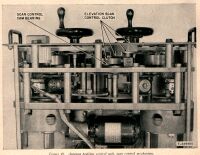
|
Instead of digital or even an analog computer, the SCR-584 used a MECHANICAL
computer in its PPI unit. State of the art in 1944! |

|
Look at the slip ring connections between the pedestal and the rotating
antenna. Here is an entire engineering project all by itself. |
![[SCR-584 Potentiometer Oil Can]](/web/20080704113657im_/http://www.hamhud.net/darts/scr584oil-t.jpg)
|
Check out the oil can used to lube (!) the potentiometers. When
was the last timeYOU had to lubricate a "pot"? |
The War (WW-II)
Many experts believe this radar changed the course of the war in favor
of the Allies. More than 700 SCR-584's were built during
WWII! With the SCR-584's abilities in gun-laying, artillery, and
anti-aircraft at their disposal, the Allies were unstoppable. Here
are some SCR-584 war stories.
-
STOPPING THE BUZZ BOMBS: The SCR-584 virtually STOPPED the
V1 "Buzz Bomb" bombardment of England, with a better than 90% kill ratio
(100 out of 104, according to Leo
Sullivan).
-
ARTILLERY CHAMP: The 115th
AAA Gun Battalion was the first to be outfitted with the then-new (and
TOP-SECRET!) SCR-584. Here are some pix
of the "D" Battery of the 518th AAA Gun Bn. with their 584, and a newer
radar.
-
EXTRA! EXTRA! A "swell" lithograph of the SCR-584 from Life
magazine, June 1943.
-
IN THE UK: Great
pix of the 225th AAA Searchlight Battalion's use of the SCR-584 during
the Winter of 1944 in the UK.
-
D-DAY: The venerable 584 was adapted
to assist in tactical air strikes.
-
BATTLE OF THE BULGE: The SCR-584 helped
ensure air superiority.
-
BACK HOME: Apparently, the Navy got worried about Axis strikes
on their Brooklyn shipyard, so SCR-584's and guns were installed at Fort
Tilden.
-
AN ORDERLY ACCOUNT: Greg Goebel emailed me about the online
history
of radar in WWII that he's putting together. Hope you enjoy it!
The Post-War Weapons Systems
Well, success breeds success, and so was the case with the Fabulous 584.
Here's some data, with links, on postwar weapons systems that included
the 584.
-
AN/MPQ-12-AN/MPM-38 (Corporal
Missile System) This US
Army field artillery missile system used a slightly modified version
of the '584 to track the missile in AZ, EL, and range. This information
was furnished to an analog computer system. A separate CW Doppler radar
determined velocity and this was also provided to the computer. The
most notable modification to the SCR-584 was the removal of the antenna
from the van (as in the SCR-784). The '584 has a lift assembly that can
raise the dish up through the roof or lower it when moving the van
to a new location. In the Corporal system, the antenna mount was moved
to a separate towed trailer. The modified radar designation was AN/MPQ-12
. There were a few other electronic modifications as well. (Thanks
Neil A.!)
-
M-m-m-my CORONA: The SCR-584 was modified to control and beacon-track
(using an onboard transponder) the CORONA spy satellite, which was the
first successful photoreconnisance satellite (covered in American
Heritage of Invention & Technology magazine). (No "skin"
returns were involved--the range was too far for the unaugmented '584.)
The '584's PRI (Pulse Repitition Interval) was changed to give an unambiguous
slant range of around 1500 miles. The modified radars were deployed at
Thule, Greenland (along with BMEWS;
brrr!); also in New Hampshire, Alaska, Hawaii, and the Indian Ocean. They
operated successfully during the 1960s before more modern trackers became
available. (Thanks Tom F.)
The Research
This truly fine radar's days were not limited to WWII; oh, no! In
fact, SCR-584s are still operational TODAY! Here are some links
and article snippets about the 584's use in postwar research, and even
some current-day stuff.
-
THE SPACE AGE: Mod
II is an SCR-584 with massive upgrades in both the antenna and the
electronics. Wow, what a sweet antenna!
-
WEATHER SEEKER: The National Severe Storms Lab in Norman,
Oklahoma has a weather
radar, used for teaching, which incorporates a 584 pedestal.
NOAA also used an unmodified
SCR-584 for a long time as an auxillary weather radar.
-
MORE WEATHER RADAR STUFF: Reader Ed Bean contributes the following:
My fond memories of the SCR-584:
In 1946 post-WWII research activities, MIT established a
Weather Radar Research Lab under the direction of Alan Bemis.
As part of the project, an SCR-584 was obtained and located on a hilltop close to
Bedford (Hanscom) AFB.
The '584 was used without modification to measure wind speed and direction at all altitudes, by tracking a
balloon-borne corner reflector kite… This data was used to correlate the various types of weather phenomena with
radar characteristics and displayed information, providing the basis for the modern day weather radar systems.
… I personally had the privilege of running the
'584 "RAWIN" [Radio WINds] station, sending up balloons in all
kinds of inclement weather. The simplicity and reliability of operation of the '584 was attested to by the fact
that the only training I received was a day or two of verbal instructions by an MIT scientist.
There were very few maintenance problems. The "J" scopes and the "PPI" scope were calibrated in mils rather than degrees,
owing to its fire-control heritage. The tracking capability was semi- automatic. The operator had to keep the
displayed signal within the limits of a range gate. This was accomplished with the aid of a motorized potentiometer
which helped to keep the range gate lined up with the signal… the antenna would stay locked on to the target signal.
During the 2 year time that I was the [RAWIN] operator, another MIT project, focused on infrared research, attached IR sensors
to the the [SCR-584] parabola to test developmental heat seeking devices related to aircraft infrared signatures.
-
MISSILES: In development,
the first generation of semi-active radar-seeking missiles used the SCR-584
for illumination. China Lake apparently still uses their '584 in
missile research (I used to have a link, but it is now dead). Wallops
Island used SCR-584's in tracking research rockets.
-
'584 HAS THE RIGHT STUFF! In the opening scenes
of the movie, "The Right Stuff",
as two test pilots challenge the "demon" of Mach 1 (one of them then-Capt.
Chuck Yeager) at Edwards AFB, an SCR-584 can be seen scanning the skies,
tracking the planes. Well, it's not really tracking, because the
'584 is clearly in its helical-scan search mode. Anyone know where they
got the '584 to make the movie with?
-
AMATEUR RADIO: a ham
operator sets up a moonbounce
station based on, you guessed it, our favorite little radar.
The SCR-584 on the Web
-
STILL KICKING: Radio-Research
Instrument Co, Inc. of Waterbury, CT. still stocks parts, manuals,
and complete
SCR-584's. Drexel
International still repairs SCR-584s.
-
JAMMING: A somewhat-funny
story of what happened to the SCR-584 (and Ivan Getting's backside!)
when the radar was first successfully jammed (on purpose).
-
NOVA: Nova documentary,
“Echoes of War”
in 1988 featured the SCR-584 at the Baltimore
Radar Museum.
-
BRITTANICA: article
which talks about the venerable 584.
-
OLD BUT RESTORABLE: Julius Hawk, whose father worked on SCR-584's
at Monmouth, NJ, sent me some pictures of an SCR-584 that he thinks is
restorable, perhaps even operable. Please keep us apprised of progress,
Mr. Hawk.

Roof mounted antenna
in the raised position. |

Power supply or modulator
cabinet, I'm not sure which. |

Full view of the trailer. |
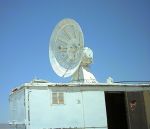
A closeup of the dish.
Oh sweet conical scan! |

Main operating console.
Notice all the dust on the PPI
panel, below. |

Rectifier cabinet? |
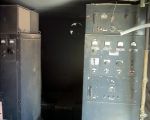 |

Mmmm, tuuuubes! |
 |
Thanks, Mr. Hawk!
|
Please use this information freely (I want to honor the accomplishments
of these men), but include a link to this page. Thanks. If
you have more information about the 584, please email me at  .
.
Last Updated: 1-1-2007
Steve Bragg KA9MVA
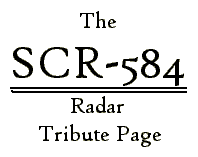












![[SCR-584 Potentiometer Oil Can]](/web/20080704113657im_/http://www.hamhud.net/darts/scr584oil-t.jpg)













 .
.